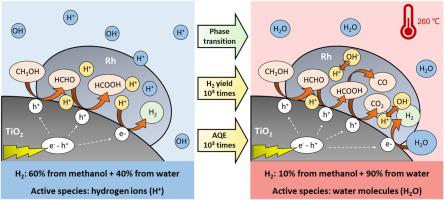Applied Catalysis B: Environment and Energy ( IF 20.2 ) Pub Date : 2020-07-06 , DOI: 10.1016/j.apcatb.2020.119316 Siyuan Fang , Yixin Liu , Zhuxing Sun , Junyu Lang , Chenyu Bao , Yun Hang Hu

|
The utilization of sacrificial reagents is one of the most common strategies to accelerate hydrogen production from water via a photocatalytic process. However, herein, solid isotope labeling evidences revealed that hydrogen was mainly produced from methanol (the sacrificial molecule) instead of water in the room-temperature photocatalytic reaction over Rh-loaded TiO2. In contrast, the production of hydrogen mainly from water was achieved by introducing thermal energy into the photocatalytic process as a novel thermo-photo catalytic approach, in which the active species changed from protons to water molecules. Furthermore, while the thermal (kinetic) energy introduced by elevating the reaction temperature could increase the oxidation driving force and thus improved the photocatalytic efficiency under visible light irradiation, photo energy in turn accelerated thermal catalysis via reducing the oxidized Rh nanoparticles and enhancing the interaction between Rh and TiO2. Consequently, 1500-fold enhancement in the hydrogen production rate under visible light irradiation was achieved. These findings not only highlight the vital importance to identify the reaction pathway of hydrogen production but also should inspire more efforts into the synergetic effects of energies.
中文翻译:

Rh负载的TiO 2上的光催化制氢:氢的来源是什么?如何从水中制氢?
牺牲试剂的利用是通过光催化过程加速从水中产生氢的最常见策略之一。然而,本文中的固体同位素标记证据表明,在室温下,Rh负载的TiO 2上的光催化反应主要由甲醇(牺牲分子)产生氢而不是水。。相反,通过将热能引入光催化过程作为一种新颖的热光催化方法,主要是从水中产生氢,其中活性物质从质子变为水分子。此外,虽然通过提高反应温度而引入的热(动能)可以增加氧化驱动力,从而提高可见光照射下的光催化效率,但光能又通过减少氧化的Rh纳米颗粒并增强了两者之间的相互作用而加速了热催化。 Rh和TiO 2。结果,在可见光照射下实现了氢生产率的1500倍的提高。这些发现不仅突显了确定氢生产反应途径的至关重要,而且应激发更多的努力来促进能量的协同作用。











































 京公网安备 11010802027423号
京公网安备 11010802027423号